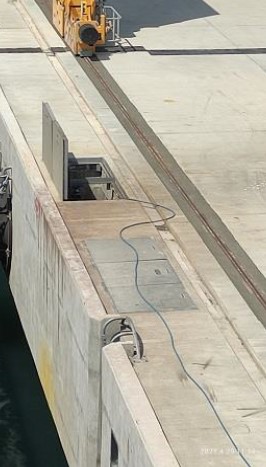Incidents relating to hatches and doors
A member reports a number of incidents relating to hatches and doors, which can be summarised briefly for our instruction here. The first two incidents are findings from a tour of the engine room on a management inspection of a vessel. The third incident is an example of proper exercise of the “Stop Work Authority”.
#1: Fire door held open by wire
A fire door in the engine room was observed to be wired open – it was being kept open with piece of wire.
What went wrong?
- Our member notes:
- Lack of safety awareness of the crew on the fire doors’ main purpose;
- No-one challenged this unsafe condition;
- IMCA notes that the deeper question as to WHY the door was wired open, is not dealt with here. Was it for convenience? Was it that the engine room was overheating?

Recommendations
Fire doors should be kept shut because they need to be closed in order to prevent the spread of fire and smoke. Propping or wedging them open compromises the safety of the vessel crew, putting them at serious risk, should a fire occur.
#2: Watertight door left open at sea
A vessel watertight door was found left open when the vessel was at sea. Watertight doors are there to prevent the ingress of water from one compartment to other during flooding or other accidents and act as a safety barrier. It is a requirement of SOLAS (section B4, regulation 22) that watertight doors shall be kept closed during navigation, except under certain conditions not met here. This company has it’s own requirement also, that all watertight doors, scuttles, and fittings below the main deck shall remain closed at all times except when actually in use.
A further check revealed no justification for keeping the door open.

What went wrong?
Our member found that persons nearby were not aware of SOLAS or company management requirements.
Recommendations
Ensure everyone understands the basics of why fire doors and watertight doors should be kept closed.
#3: Hatch left open on the quay – a successful intervention prevents a potential accident
Two open hatches on the wharf in close vicinity to the vessel were observed and reported by vessel crew members. There were no barricades or safety signs installed, despite the potential fall hazard inside from 2 m height. Following this intervention, the hatches were closed and locked by wharf service personnel.
What went right?
The crew challenged an unsafe condition, although it was not directly related to the vessel. This is an excellent example of proactive application of the principle of “Stop the job”. Remember that everyone has the authority – and the duty – to STOP THE JOB if work is taking place that is clearly unsafe.

Members may wish to refer to:
Safety Event
Published: 12 July 2021
Download: IMCA SF 19/21
IMCA Safety Flashes
Submit a Report
IMCA Safety Flashes summarise key safety matters and incidents, allowing lessons to be more easily learnt for the benefit of all. The effectiveness of the IMCA Safety Flash system depends on Members sharing information and so avoiding repeat incidents. Please consider adding safetyreports@imca-int.com to your internal distribution list for safety alerts or manually submitting information on incidents you consider may be relevant. All information is anonymised or sanitised, as appropriate.
IMCA’s store terms and conditions (https://www.imca-int.com/legal-notices/terms/) apply to all downloads from IMCA’s website, including this document.
IMCA makes every effort to ensure the accuracy and reliability of the data contained in the documents it publishes, but IMCA shall not be liable for any guidance and/or recommendation and/or statement herein contained. The information contained in this document does not fulfil or replace any individual’s or Member's legal, regulatory or other duties or obligations in respect of their operations. Individuals and Members remain solely responsible for the safe, lawful and proper conduct of their operations.
